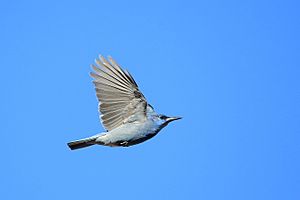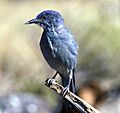Pinyon jay facts for kids
Quick facts for kids Pinyon jay |
|
|---|---|
 |
|
| Conservation status | |
| Scientific classification | |
| Genus: |
Gymnorhinus
|
| Species: |
cyanocephalus
|
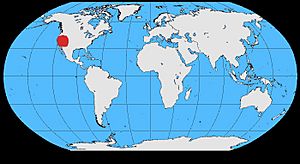 |
|
| Distribution (all-year resident) | |
The pinyon jay (Gymnorhinus cyanocephalus) is a type of jay bird. It is about the size of a North American blue jay. Its call sounds like a rhythmic krawk-kraw-krawk, repeated a few times. This bird is special because it's the only member of its group, called Gymnorhinus.
Pinyon jays are bluish-grey with a darker blue head and a white throat. They have a black bill, legs, and feet. They are very social birds, often living in large flocks of 250 or more. Some birds in the flock act as lookouts, watching for dangers while the others eat. Their main food is pinyon pine seeds, but they also eat fruits, berries, and many types of insects. They sometimes catch insects with their feet!
These birds always build their nests in a colony, but only one nest is built in each tree. Colonies can spread over large areas, with nests in trees like juniper, live oak, or pine. Females usually lay 3 to 4 eggs early in the season. The eggs hatch after about 16 days. The male brings food to the female, who then feeds the chicks. Young birds leave the nest around 3 weeks later.
The pinyon jay was first officially described in 1841 by a German explorer, Prince Maximilian of Wied-Neuwied. He found a specimen in Montana. These birds live in western North America, from central Oregon to northern Baja California, and as far east as western Oklahoma. They prefer foothills where pinyon pines grow.
Contents
About the Pinyon Jay
The pinyon jay was first described by German explorer Prince Maximilian of Wied-Neuwied in 1841. He found the bird during his trip to North America in 1833.
This bird is the only species in its group, called Gymnorhinus. There are no different types (subspecies) of pinyon jays. Scientists have studied their genes and found that pinyon jays are related to scrub-jays and blue jays. The official common name for this bird is "pinyon jay." In the past, it was also called the blue crow or Maximilian's jay.
Where Pinyon Jays Live
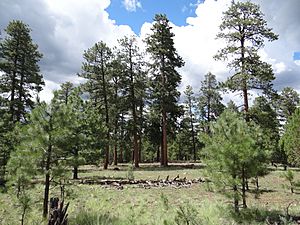
Pinyon jays live in western North America. You can find them from central Oregon to western South Dakota, and south to northern Baja California and western Oklahoma. They stay in these areas all year round. Sometimes, if there aren't enough pinyon seeds, they might travel to other places like central Washington or northern Idaho.
These birds live in woodlands with pinyon pine and juniper trees. They also live in low-elevation ponderosa pine forests. Pinyon-juniper woodlands have trees like Colorado pinyon and Utah juniper. Pinyon jays depend on these trees for food, nesting spots, and places to rest. In return, the jays help spread the seeds of the pinyon trees, which helps the trees grow in new places.
Pinyon trees start growing cones with seeds when they are about 25 years old. They produce a lot of seeds every 3 to 7 years. When there are many seeds, it's called a "bumper crop." These big seed crops help the pinyon jays breed more successfully.
Their Environment
Pinyon-juniper woodlands are usually dry or semi-dry. The average temperature is between 40 and 61 degrees Fahrenheit (4–16 degrees Celsius). Ponderosa pine forests also have dry to semi-dry climates. Weather is very important for how well pinyon jays breed and survive.
The amount of rain and snow in these areas changes a lot. It can range from 10 to 22 inches (254–559 mm) per year. Spring and summer are often dry. Heavy spring snow can make it hard for pinyon jays to nest.
Pinyon-juniper woodlands are found on hills, mesas, and low mountains. They are usually between 4,000 and 8,000 feet (1,219–2,438 m) high. Ponderosa pine forests are most common from 6,000 to 8,500 feet (1,800–2,600 m). Pinyon jays have even been seen at very high elevations, up to 11,500 feet (3,505 m).
Pinyon Jay Behavior
Pinyon jays are noisy birds that live in groups. These groups can have 250 to 500 birds, or even thousands! They spend most of their time looking for seeds to eat right away, or to hide in the ground or tree cracks for later. They use pinyon, western juniper, and ponderosa pine trees for shelter. Before they go to sleep for the night, a flock of pinyon jays might fly 1 to 3 miles (1.6–4.8 km) away from where they were eating. They often huddle together in small groups of 3 to 5 birds when they roost.
Mating and Reproduction
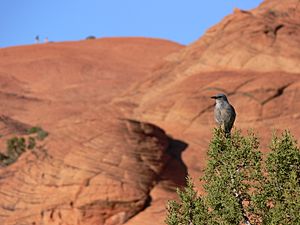
Pinyon jays stay in large flocks all year. The only time the flock changes a lot is during the breeding season, in January and February. At this time, the flock splits into two: one for breeding birds and one for younger, non-breeding birds. Sometimes, a third flock forms with pairs who didn't succeed the first time and want to try again. Even when separated, they remain very social.
Pinyon jays usually choose one partner for life. They stay together for about 2.5 years on average. Males start breeding around 2 years old, and females around 1.5 years old.
Pinyon jays breed in pinyon-juniper woodlands and ponderosa pine forests. They start breeding in January or early February when the days get longer. They might breed again in August if there are lots of green pinyon cones and seeds. Breeding activities, from building nests to feeding young, happen almost every month except December. They are most successful after a large pinyon seed crop. If there are many seeds, they can hide plenty and start breeding earlier, usually in January. If there are huge amounts of seeds, they might even breed twice a year!
When it's time to find a mate, all the adult birds in the flock form "courtship parties." These groups fly several miles away from the main flock to breed in a colony.
Nesting Habits
Nesting happens from late February to April. Having enough food is very important for choosing a nesting spot. Many pairs build nests together in loose colonies at the same time. During nesting, breeding pairs sleep with the main flock and eat together for about 1.5 hours each morning.
Nests are built in pinyon, western juniper, or ponderosa pine trees. They are made of twigs and shredded bark. Pinyon jays in cities have even been seen using trash and paper for their nests! Nests are usually built about 18.4 feet (5.6 m) high in ponderosa pine trees, with lots of cover above them. Nests are built 50 to 500 feet (15–152 m) apart from each other.
Pinyon jays are very good at adapting. For example, they learn to choose better nest locations after dealing with predators. Older jays (7 years or more) learn to build nests lower to the ground for better hiding. They also build them further from the tree trunk early in the season to get more sun and stay warm while sitting on their eggs.
Females usually lay 3 to 5 eggs. In some years, more than 40% of nests had 3 or fewer eggs. Larger clutches (4 or more eggs) were more common when there were lots of pinyon seeds.
While the female sits on the eggs, the males leave to form their own feeding flock. The male brings pinyon and ponderosa pine seeds to the female. Eggs usually hatch after 17 days. If a pair's first nesting attempt doesn't work, they might form smaller "satellite" colonies in late April to try again.
Raising Young Birds
All the young pinyon jays in a colony usually leave their nests within 6 days of each other because breeding is synchronized. To keep the young warm, females stay on the nests constantly. Females and young are fed seeds that the parents bring. For the first 12 to 15 days after hatching, usually no more than two male birds feed the nestlings. However, up to seven adult male birds (often sons from the previous year) might help feed the nestlings during the last 4 days in the nest and for 20 days after they leave. Some adult pinyon jays who didn't have success with their own nests might help feed other young birds.
Young pinyon jays leave the nest about 3 weeks after hatching. Eight days later, they learn to feed themselves, mostly eating insects and soft plants. Pinyon and ponderosa pine seeds are eaten as a backup food. The parents continue to feed them for up to a month, but less often. Young pinyon jays become independent at 8 weeks old. After leaving the nest, adults and young stay in a close-knit feeding group until late summer. In the fall, young birds either stay with their birth flock or leave to join other flocks. Young females usually leave to find mates in new flocks, while males often stay with their birth flock to breed or help their parents.
Staying Safe from Predators
Predators can be a big danger for pinyon jays. However, living in flocks, nesting in colonies, and mobbing (ganging up on) predators help keep them safe. In one study, 4 to 12 pinyon jays in a flock acted as lookouts. They would sit high in a tree, watching silently while the flock ate. If a predator came near, they would make a warning call, and the flock would stop eating and hide in the trees.
Pinyon jays have been seen mobbing large birds like horned owls and different types of hawks. They also mob gray foxes.
Studies have shown that ravens and crows are the main predators of pinyon jay nests, causing about 76% of identified attacks. Other predators include Steller's jays, Abert's squirrels, and rock squirrels. Ground predators like snakes, gray foxes, and even domestic cats also attack nests. Sometimes, female pinyon jays are pulled from their nests at night because they don't want to leave their eggs.
Survival Rates
Generally, adult pinyon jays have a better chance of surviving than younger birds. Nests are more likely to fail in years when pinyon trees don't produce many seeds. Breeding in late winter and early spring can result in fewer young birds surviving, unless there was a very large pinyon seed crop. If they breed a second time in August or September, many young birds might die if the weather gets bad quickly in late fall.
One study found that most pinyon jays died in the fall. This might be because they are more active looking for seeds in new places, which makes them more open to predators. On average, 74% of adults, 62% of yearlings, and 41% of young birds survived each year. Female pinyon jays had a lower survival rate than males, possibly because they are the ones sitting on the eggs and young.
Another study found that the survival of pinyon jays of all ages was more connected to the weather than to how many pinyon seeds were available. Young birds had a better chance of surviving when spring weather was warm and wet, and there were many pinyon seeds. Adults also survived better in warm, wet spring weather.
Sometimes, adult pinyon jays might leave their nests. This could happen if the young birds are too cold and can't keep themselves warm. It might also happen if a predator has already attacked the nest, as the parents know the predator might come back.
What Pinyon Jays Eat
Pinyon jays are perfectly built and behave in ways that help them eat pinyon seeds. Pinyon seeds are heavy and don't have wings, so they can't be spread by the wind. Birds, animals, and humans are needed to move them around. Pinyon seeds are very healthy. They contain protein, fat, and carbohydrates, plus vitamins and minerals. Pinyon cones take three growing seasons to become fully ripe. However, pinyon jays can eat seeds from one-year-old green cones, which are ready by late August. Each cone has about 20 seeds. Ponderosa pine seeds are also an important food for them.
Besides pinyon and ponderosa pine seeds, pinyon jays eat seeds from other pine trees and juniper berries. Insects like caterpillars, beetles, grasshoppers, and ants make up a big part of their diet. They also eat spiders. In winter, they might eat grains like corn, beans, and wheat from farms. Pinyon jays have also been seen eating soil near salt blocks meant for cattle.
Young nestlings eat insects, soft plants, and pinyon seeds when there are plenty.
How They Find Food
Pinyon jays form flocks of 50 to over 500 birds, sometimes even thousands! They start looking for food together in late August. Being in a flock helps them find food more easily and protects them from predators. Pinyon jays sometimes have to fly long distances to find cones when there aren't many in their area. Different flocks might cross paths and stay in touch by calling to each other.
Sometimes, pinyon jays will join flocks with other birds like hairy woodpeckers, downy woodpeckers, and Clark's nutcrackers. This helps them stay safe from predators while eating and find food that is spread out.
Pinyon jays look for insects and hidden seeds on the ground and in fallen trees. They also search in cracks in live trees for hidden pinyon seeds. They eat new growth on ponderosa pine branches and look for cones in the treetops. If a cone is ripe but closed, the pinyon jay will take it to a place where it can hold it open with its feet. Then, it uses its beak to hammer the cone open. Pinyon jays can tell if a seed is full or empty by its color, weight, and the sound it makes when they tap it with their beaks. A pinyon jay can hold up to 43 ponderosa pine seeds and 56 pinyon seeds in its stretchy throat!
Storing Food (Caching)
Hidden seeds give pinyon jays energy for mating, building nests, laying eggs, and sitting on them. Pinyon jays fly up to 7.5 miles (12 km) to hide pinyon and ponderosa pine seeds for later. They hide most seeds in the fall. From November to February, hidden Colorado pinyon seeds make up to 90% of their diet. They put 1 to 7 seeds in each hiding spot, and one pinyon jay can hide over 20,000 seeds in a single season! One flock of pinyon jays in New Mexico was thought to hide 4.5 million seeds in one year. Pinyon jays might even re-hide seeds to stop other jays, like Steller's jays, from stealing them.
They hide seeds both on and off the ground, depending on the season. On the ground, they hide seeds in areas with little plants and bare, well-drained soil. They bury seeds in dead needles and twigs, and between organic material and the soil. They often hide seeds close to the tree trunk, usually on the south side where snow melts fastest. They stop hiding seeds on the ground when snow covers it.
In winter, pinyon jays hide many more seeds in places above the ground, like in the cracks of tree bark. This is probably because the ground is cold and covered in snow.
Pinyon jays living near people have been seen taking and hiding sunflower seeds, pinyon seeds, peanuts, and millet from bird feeders. They can remember specific places where other jays hid seeds for at least two days. They can remember general areas of hidden seeds for at least seven days. This good memory helps them find their stored food.
Seasonal Diet Changes
Pinyon jays mainly eat pinyon seeds in late summer and ponderosa pine seeds in fall and early winter. A flock of pinyon jays in Arizona spent 80% of their time looking for food in ponderosa pine forests in late November and early December. The rest of the time, they were in open grassy areas and pinyon-juniper woodlands. When there was snow in the grassy areas, the flock spent 60% of its time in the pinyon-juniper woodlands, where snow rarely covered the ground.
In the fall and winter, pinyon jays have also been seen eating Gambel oak acorns in areas where these oak trees grow.
Pinyon Jay Status
The Pinyon jay is listed as a Vulnerable species by the International Union for the Conservation of Nature. This means their numbers are decreasing, and they could be at risk.
Between 1859 and 1880, a lot of pinyon woodlands were cut down for mining and making charcoal. This likely caused millions of pinyon jays to die. More recently, between 1950 and 1964, about 3 million acres of pinyon woodlands were used up.
The future of the pinyon jay is a concern, mainly because of how climate change affects their pinyon-juniper homes. Also, how people manage these habitats can impact the birds. For example, thinning trees or using chemicals in pinyon-juniper woodlands to reduce wildfire risk can make pinyon jays stop nesting in those areas. Human developments like oil and gas wells also affect them, as they tend to avoid nesting near these sites. A worldwide decline in insect populations, which are a food source for the jays, is also a worry.
Images for kids
![]() This article incorporates public domain material from the United States Department of Agriculture document "Gymnorhinus cyanocephalus".
This article incorporates public domain material from the United States Department of Agriculture document "Gymnorhinus cyanocephalus".
External image links
See also
 In Spanish: Chara piñonera para niños
In Spanish: Chara piñonera para niños



